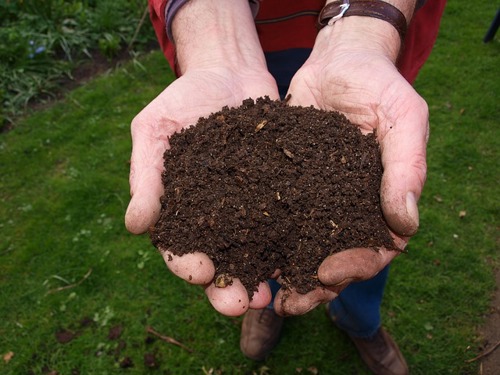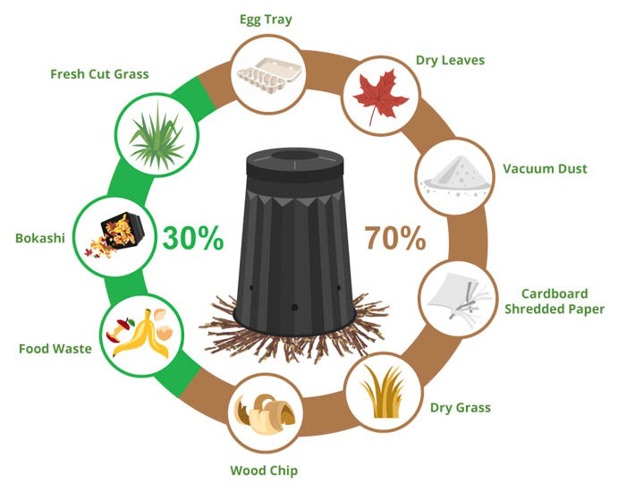Compost is a natural soil conditioner made from organic waste. The material is from plant and animal origin, mixed together to hasten the process of decay. It is ready to use when the original material is unidentifiable. It has a dark brown, crumbly texture and pleasant earthy odour.
The material we call soil is a complex mixture of eroded rock, mineral nutrients, decaying organic matter, water, air and billions of living organisms, most of them microscopic decomposers. Although soil is potentially a renewable resource, it is produced very, very slowly by the weathering of rock, the deposit of sediments by erosion and the decomposition of dead organisms. Soils develop and mature so slowly that it takes between 200 and 1000 years to develop 25mm of topsoil.
The importance of healthy soil
The importance of healthy soil is summed up in the motto of The New Zealand Soil and Health Association:
Healthy Soil - Healthy Food - Healthy People
Oranga nuku - Oranga kai - Oranga tangata
In Over 80% of the agricultural soils in the developed world contain only 1-3% of organic matter. For a good, strong soil to grow healthy food, it must contain at least 6-10% of organic matter.
In New Zealand 40% of household waste is compostable materials in the form of food waste, garden materials, food contaminated paper, tissues and hand towels. Why not use these resources to help improve your garden and grow some veggies?!

Compost ticks all the boxes
- Improves soil quality
- Increases productivity
- Reduces water use
- Reduces pesticide and fertilizer use
- Reduces nutrient run-off
- Reduces soil erosion
- Supplies the calcium, phosphorous, lime, nitrogen and potassium needed for plant growth
- Improves drainage in heavy clay soil and conserves water in light sandy soil
- Keeps the soil cooler in summer and warmer in winter
- Increases aeration in compacted soil
- Promotes root growth and creates spaces in the soil for air and water
- Saves landfill space
- Reduces the need to transport your green waste to the dump
- The amount of water pollution, gas release and odour from landfill is decreased
Build your own bin with your own materials. Watch the below video from Dr Compost on the simplest compost heap!
How to compost
Check out this Consumer NZ review of different composting options to learn about the pros and cons of different systems and what might best suit your needs.
You can buy composting bins online or from hardware stores.
- Earthmaker's patented three-stage process uses traditional three-bin composting but stacked vertically so gravity does the hard work!
- Black bins, tumblers and other composting accessories available from:
Four ingredient compost recipe
For a well-functioning compost heap you will need:
- Micro-organisms: Compost is made by billions of microbes that digest the food you provide for them. All this microbial activity will make the compost heap hot. To function, the microbes need oxygen, water and food.
- Air: Create air tunnels in your heap by poking sticks through it, or by turning the pile, by breaking up any clumps of compost, or by adding compost worms, who will make their own air tunnels.
- Water: An ideal heap contains as much water as a wrung out sponge – damp and moist, not wet. A dry compost heap will die, as will one which is too wet, which makes the heap heavy and squashes the air out of it. If you are using kitchen as well as garden waste in your heap, there should be enough moisture in the leftover fruit, animal and vegetable materials to keep the heap balanced.
- Food: Compost needs both ‘brown’ (carbon) and ‘green’ (nitrogen) food to work properly. Browns (carbon) are generally dried materials like autumn leaves, straw, dead weeds, twigs and branches, wood chips, sawdust and paper and paperboard products. Greens (nitrogen) are fresh plant materials like fruit and vegetable scraps, other food waste, grass cuttings, weeds and other plant matter.

Diagram from The Compost Collective
Variety is the spice of life
Try mixing up your food ingredients layering "brown" and "green" materials in a bin.
- Food scraps
- Garden prunings, weeds and grass
- Pencil sharpenings
- Cork
- Paper products
- Natural fabrics – wool, cotton, silk
Composting is a biological process, and a compost pile is really a teeming microbial farm. There are more living organisms in a teaspoon of good compost than there are beings on the earth. Creation of heat cooks the materials into compost. Once a heap has been built, billions of creatures will create the necessary heat to begin the process. Weed seeds and pathogens should be killed if the heap stays at around 55 – 60 degrees C for 5 – 7 days. Bacteria start the compost making process of organic matter breakdown. Populations of fungi, protozoans and round worms then increase, while insects, beetles and other animals follow later.
Using compost
Caution: As compost contains a variety of living organisms, it is wise to take some precautions when handling it:
- Wash your hands after handling soil or compost materials
- Protect broken skin by wearing gloves
- Avoid handling compost in unventilated spaces
- Avoid inhaling dry compost or potting mixes
Compost is ready to use when it has turned dark brown and gone crumbly, with a smell like the heart of a forest. If used too soon, the compost may borrow nitrogen from the soil to finish breaking down, which will reduce the amount of nitrogen available to growing plants.
- Do not pile compost up against tree trunks or plant stems as this may lead to fungal decay, - the stems and trunks need air to circulate.
- Do not put compost at the bottom of the hole when planting trees or shrubs – rather mix it with equal parts of topsoil.
- Partly decayed compost can be used as a mulch, but do not dig it in deeper than 15cm or hydrogen sulfide gas will be created, which is toxic to plant roots.
- Make compost ‘tea’ by filling a cloth bag with a litre of compost. Tie the bag and soak in a bucket of water. Let it ‘steep’ overnight and then pour around soil of plants. If you leave the tea longer than overnight, make sure you dilute it with equal parts of water before pouring.
Facts and figures
- An acre of good, living soil can contain 900 pounds of earthworms, 2400 pounds of fungi, 1500 pounds of bacteria, 133 pounds of protozoa, 890 pounds of arthropods and algae. They are sometimes called the ‘micro herd’ – the most important livestock on any farm.
- Regular use of quality compost has shown yield increases of up to 15% for lettuce and broccoli; irrigation water savings of 10% in summer on sandy soil; significant fertiliser savings, faster maturation of crop and more even crop quality.
- Biologically active soils are less likely to support disease-making organisms. Compost has been shown to contain certain microorganisms that can suppress or kill disease-causing organisms such as root rots and nematodes.
- Farm compost trials in Australia show that improved organic matter levels resulted in positive effects on moisture holding capacity, bulk density, cation exchange capacity, pH and reduced erosion.
- Research indicates that for every 1 acre of land which we bring back to a 6% level of organic matter, we would be sucking up to 12 tonnes of greenhouse gases out of the atmosphere and into the soil. Any composting has a positive effect on reversing the volume of greenhouse gases in the atmosphere. (Peter W. Rutherford & Mary Lou Lamonda: The Australian worm and compost Book,1994.)
Bokashi Composting
Another way to break down household organic waste is with a Zing Bokashi composting unit. This can be used on its own or as a complimentary addition to your other composting systems.
Zing Bokashi offers a product called EnsoPet which provides a simple and hygienic way to compost pet waste. Some Councils offer EnsoPet products at a reduced cost - ask your local Council if it sells these products.
Check out their website for details and the below video from Dr Compost as an overview.
Other composting techniques
Check out our other pages for more information on worm composting and commercial composting.
Composting Links
- The Compost Collective
- Dr Compost (Waste Busters)
- Consumer NZ reviews of different systems
